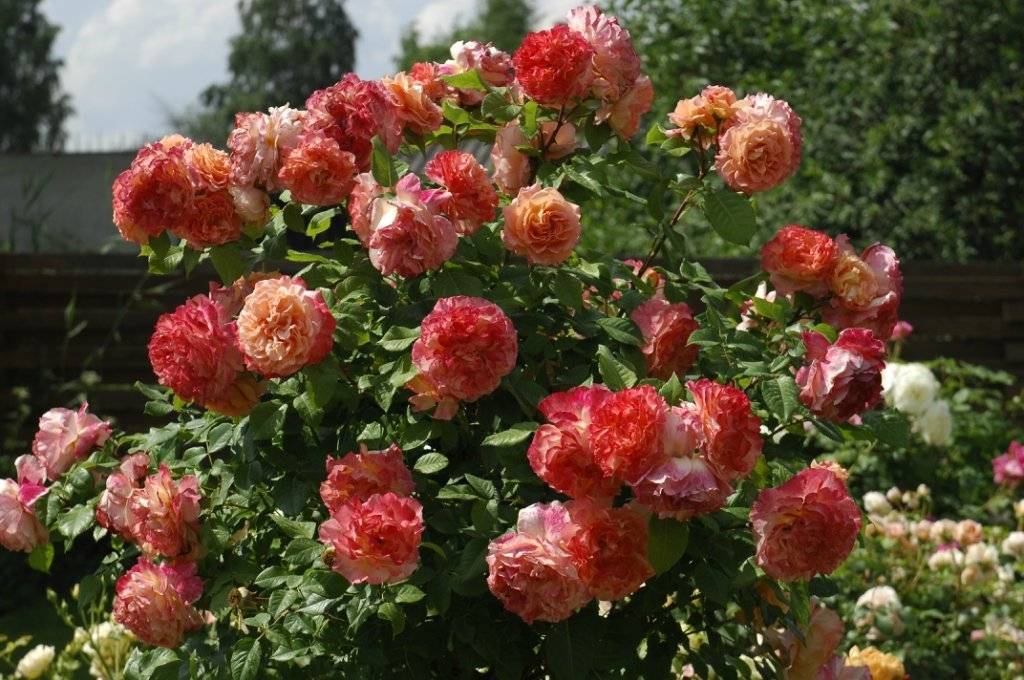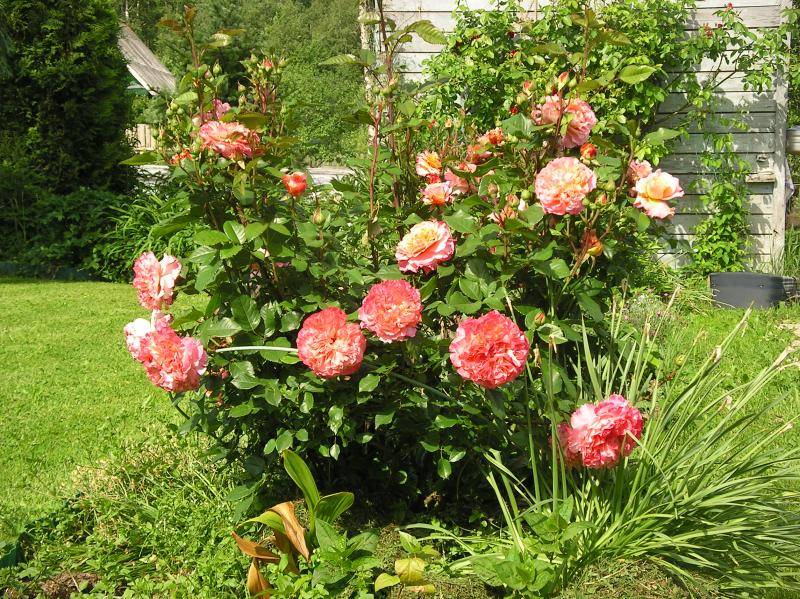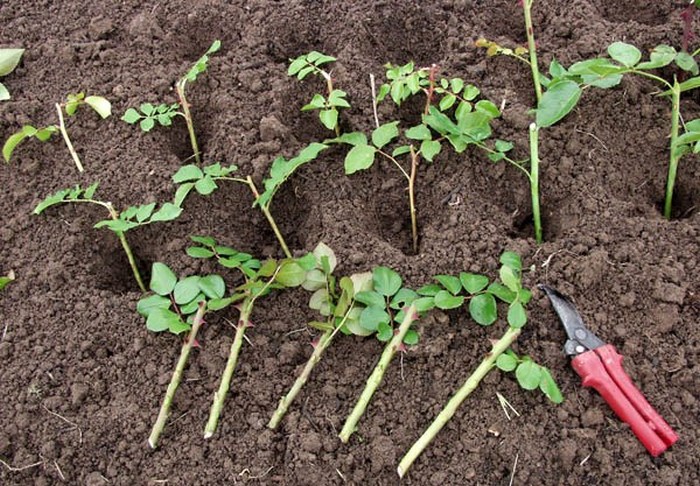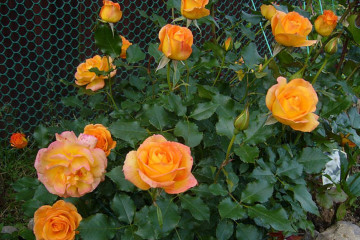Rose Augusta Luise (Augusta Luise) - characteristics of the variety
Content:
The hybrid tea variety Augusta Louise attracts attention with its dense double flowers of an unusual color. An aristocratic perennial in appearance is quite suitable for growing on a personal plot, if you follow all the care requirements.
Rose Augusta Luise (Augusta Luise): description and characteristics
Originally rose Augusta Luise was bred in France by a scientist named J. Guyot in 1867. Later, the variety was lost and was re-obtained by German breeders of the Tantau company in 1999. The plant was named in honor of Countess von Stolberg (1753-1835 biennium .), and its presentation to the public was timed to the anniversary of I. Goette himself.
The bush, formed by strong erect shoots, reaches a height of 1 m. The stems are covered with large matte foliage of a dark green color. The flowers are large, up to 15 cm in diameter, their colors are heterogeneous: the petals are painted in all possible shades of pink and orange - creamy peach, golden apricot, champagne, coral. Fruity aroma with distinct raspberry notes.
In landscape design, the rose Augusta Louise is used for single plantings against the background of a green lawn, and is also planted as part of compositions. The bush, formed in the form of a trunk, looks great.
The advantages of the variety are:
- unpretentiousness to disease;
- frost resistance;
- long flowering right up to the coldest temperatures.
Among the shortcomings, they note the poor tolerance of precipitation and direct sunlight.
How to properly plant in open ground and grow a flower
The variety can be called quite persistent and unpretentious. But when growing it, you will have to follow certain rules.
Spring planting is recommended when the ground has already warmed up enough and the threat of frost has passed. In autumn, young bushes are planted in the ground at the end of September, when there is still at least a month for rooting before frost.
Seat selection
The site for planting should be moderately lit by the sun. The place should be clearly visible so that you can admire the flowering noble plant. But it is important to provide protection against drafts.
How to prepare the soil and flower for planting
Before planting in the ground, seedlings are carefully examined, removing non-viable roots, and then left overnight in settled water. Sand and humus are mixed with the soil at the planting site in advance with the addition of bone meal.
Step-by-step planting procedure
It is important to follow the correct procedure when planting. It is recommended to follow these steps:
- Dig a hole 2 bayonets deep with a shovel.
- Pour drainage at the bottom, covering it with a layer of earth.
- Lower the seedling into the hole, carefully spreading the roots.
- Sprinkle soil over the roots and compact with your hands.
- Water and mulch the planting site.
Plant care
Any richly flowering plant requires special care. Rosa Louise is no exception, growing it, it is important to adhere to competent agricultural technology.
Watering rules and humidity
Water the plant in moderation, no more than 1 time per week. If it rains for a long time, then watering should be limited so that the roots do not start to rot. A couple of days after moistening, the soil around the bush is loosened so that the moisture does not evaporate too quickly.
Top dressing and soil quality
The rose is fed in the spring, adding nitrogen-containing compounds, and at the stage of bud formation, mixing coal with water for irrigation. During flowering, the plant needs phosphorus and potassium.
Pruning
The pruning procedure is carried out in early spring using sharp, sterile instruments. Remove all poorly overwintered shoots. In the summer, unripe buds and faded corollas are removed. Throughout the season, wild shoots are cut off from the grafted bush.
Features of wintering a flower
The flower hibernates only under cover, although it can withstand frosts down to -23 ⁰C. Before wintering, the plant is treated with a fungicide and the soil around the bush is loosened. Next, the rose is spud, covered with spruce branches and a non-woven fabric is pulled on top.
Blooming rose
The rose of Augustine Louise blooms in waves. The first flowering is distinguished by the brightest aroma, the summer wave is the most abundant, and the final one is the longest, continuing until frost.
A period of activity and rest
Augusta blooms for the first time this season in June, throwing off the last buds not earlier than September. There may be short rest periods between flowering waves.
Care during and after flowering
When the bush is resting from flowering, it should be fed so that it regains strength. Timely removal of dry withered flowers will promote the abundant formation of new buds.
What to do if it does not bloom
Augusta Louise blooms poorly in extreme heat and when rainy summer is issued. In a grafted plant, it is necessary to remove wild shoots in time so that they do not deprive the bush of nutrition. Lack of dressing and violation of care requirements can also interfere with the formation of buds.
Flower propagation
To preserve varietal characteristics, the rose is propagated by cuttings.
Sections are taken from young, strong bushes after the first wave of flowering is completed. It is the shoots cut in mid-June that root best.
When grafting, a certain procedure should be followed. Its sequence is as follows:
- Cut off viable shoots 20-25 cm long.
- Each shoot is divided into segments so that they have 3-4 buds left. The workpieces must have an oblique bottom cut and a straight top cut.
- The lower leaves are cut off.
- The cuttings are kept in a root growth stimulator.
- The workpieces are placed in the ground, watered and covered with glass jars.
- Until the time of rooting, the cuttings are regularly sprayed and ventilated.
- For the winter, the seedlings are covered with dry foliage, and with the onset of spring heat, they are transplanted to a permanent place.
Diseases, pests and ways to control them
Roses of this variety are often attacked by aphids. In order to identify the pest in time and begin to combat it, it is recommended to regularly conduct a preventive inspection of the bush. You can fight the pest with the help of folk remedies or insecticidal preparations.
Sometimes burn marks can be observed on the delicate leaves of the plant. In this case, you cannot do without the use of fungicides.They are sprayed with rose bushes throughout the summer season.
The detection of black spots on the plant after the end of winter indicates the appearance of a fungal disease. The affected shoots are cut and burned, and the cuts are treated with medicinal compounds, for example, ranet. For prevention, you can spray the bush with a solution of copper sulfate.
Subject to the correct cultivation and care technology, you can even grow such a whimsical rose as Augusta Louise in your garden. Its luxurious, fragrant flowers will more than cover every effort.



















